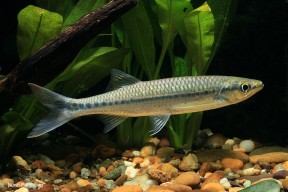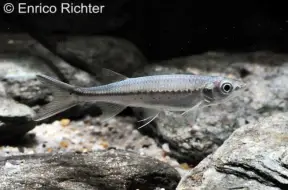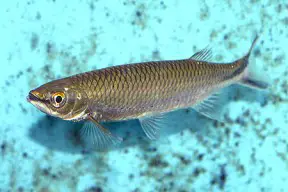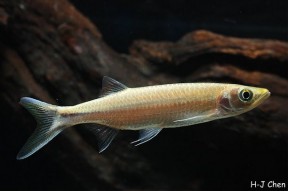Luciosoma setigerum
Apollo Shark
SynonymsTop ↑
Barbus setigerus Valenciennes, in Cuvier & Valenciennes, 1842; Barbus podonemus Bleeker, 1849; Luciosoma weberii Popta, 1905
Etymology
Luciosoma: from the Latin lucius, meaning ‘a fish (probably the pike)’, and Ancient Greek σῶμα (sôma), meaning ‘body’, in reference to the elongate, pike-like body shape in members of this genus.
setigerum: from the Latin setiger, meaning ‘bristly’, presumably in reference to the extended, filamentous first pelvic fin ray in this species.
Classification
Order: Cypriniformes Family: Cyprinidae
Distribution
As currently understood this species has an extremely wide distribution throughout much of Southeast Asia. Records exist from the Mekong River basin in Thailand, Laos, Cambodia, and Vietnam, the Chao Phraya and Mae Klong watersheds in central and western Thailand, respectively, various smaller drainages in peninsular Thailand and Peninsular Malaysia, and the Greater Sunda Islands of Borneo, Sumatra, and Java. It may also occur in eastern Myanmar but this remains in need of confirmation.
Type locality is ‘Pébak River, Java, Indonesia’.
Habitat
A riverine species displaying a preference for slowly-flowing lowland rivers with substrates of leaf litter and submerged woody structures, but also moves into swamps and inundated forest during the wet season.
Maximum Standard Length
200 – 220 mm.
Aquarium SizeTop ↑
An aquarium with surface dimensions of 240 ∗ 60 cm or equivalent should be the smallest considered.
Maintenance
Choice of decor is not as critical as water quality and the amount of open swimming-space provided, although it is likely to thrive in an aquarium set up to resemble a flowing stream or river with a substrate of variably-sized, water-worn rocks, sand, fine gravel and perhaps some small boulders.
This can be further furnished with driftwood roots or branches, and while the majority of aquatic plants will fail to thrive in such surroundings hardy types such as Microsorum, Bolbitis or Anubias spp. can be grown attached to the décor.
Though very fast flow is unnecessary it should also prefer a relatively high proportion of dissolved oxygen and moderate water movement. Weekly water changes of 30-50% volume should also be considered routine, and the tank must have a very tightly-fitting cover as all Luciosoma spp. are accomplished jumpers.
Water Conditions
Temperature: 20 – 26 °C
pH: 6.0 – 8.0
Hardness: 36 – 215 ppm
Diet
The major proportion of this species’ natural diet is composed of terrestrial insects which are captured at the water surface, although presumably it also feeds on aquatic invertebrates, fish fry and suchlike.
Sexual Dimorphism
Sexually mature females are likely to be deeper-bodied than males.
NotesTop ↑
Luciosoma species are only suitable for the largest private aquaria, although subadults of L. setigerum, L. bleekeri, and an unidentified fish with a distinctive colour pattern (see below) are traded on a regular basis. They are mostly marketed as ‘apollo shark’, ‘shark minnow’, or similar, and often labelled with incorrect scientific names.
Luciosoma spilopleura is used very commonly, for example, but that species may never have been collected for aquaria. Similarly, L. pellegrinii is scarcely known in the aquarium trade since it is native to an area where very few commercial collections take place, but its name is misapplied on a regular basis.
The five species which currently comprise Luciosoma can be identified by elements of colour pattern. L. setigerum is most-easily distinguished from the congener L. bleekeri, with which it is frequently confused, by presence (vs. absence) of a series of black spots on the lateral line scales.
It can be distinguished from other members of the genus by the following combination of characters: dark lateral body stripe typically interrupted by spots and extended into a black blotch at the base of the upper caudal-fin lobe; lower caudal-fin lobe with a submarginal stripe, median rays colourless; spots present on lateral line scales; barbels well-developed; no tubercules on snout; anterior pelvic-fin ray extended into a filament.
There is a fish of unknown geographical origin which matches the majority of diagnostic features for L. setigerum with the exception that the dark lateral stripe is absent in the anterior portion of the body and is not composed of interconnected spots. It is relatively common in the aquarium trade and included here as L. cf. setigerum until a confirmed identity is established.
References
- Cuvier, G. and A. Valenciennes, 1842 - Histoire naturelle des poissons v. 16: i-xx + 1-472
Tome seizième. Livre dix-huitième. Les Cyprinoïdes. - Kottelat, M., 2013 - Raffles Bulletin of Zoology Supplement 27: 1-663
The fishes of the inland waters of southeast Asia: a catalogue and core bibiography of the fishes known to occur in freshwaters, mangroves and estuaries. - Kottelat, M., 2001 - WHT Publications, Colombo: 1-198
Fishes of Laos. - Oijen, M. J. P. van and G. M. P. Loots, 2012 - Zoologische Mededelingen 86: 1-469
An illustrated translation of Bleeker’s Fishes of the Indian Archipelago Part II Cyprini. - Rainboth, W. J., 1996 - FAO, Rome: 1-265
FAO species identification field guide for fishery purposes. Fishes of the Cambodian Mekong. - Roberts, T. R., 1989 - Memoirs of the California Academy of Sciences 14: i-xii + 1-210
The freshwater fishes of western Borneo (Kalimantan Barat, Indonesia).





